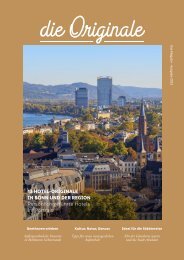LUXAIR_LUXiClub_So12 ls
p o
p
o
Create successful ePaper yourself
Turn your PDF publications into a flip-book with our unique Google optimized e-Paper software.
Number 43, Fall 2002
cartographic perspectives 15
to chart our mappemounde of love” (228 and n.23). Margaret, in turn, called
Birney her “flammenwerfer love” (“German flame-thrower”), alluding to
their intimacy and to his time at a flame-throwing unit in Sussex (229 and
n.27). And Birney’s Cetegrande echoes Margaret’s interest in medieval
French (220 and 225) even as it recalls her lines: “In the great ocean of our
love, whales/ are the utterance to swing your being’s tide” (242).
To the brevity of life, a theme already evident on many mappaemundi,
Birney has added the dissolution of faithfulness and love.
Epilogue: After “Mappemounde”
Time, the great bugbear in “Mappemounde,” was also to be a healer in
Birney’s life. He and Margaret remained friends until she hurt him irreparably
years later by selling the letters and poems he had once written
to her. His marriage to Esther withstood his ambivalence and love-affairs
until 1977, three decades after his return from the war. By that time, Birney
had discovered in Wailan Low the ideal companion for the final quarter
century of his long life (Cameron 1994, 518-570; “...o many and many/ and
happiest years”: Birney 1975, 2:180).
In the meantime, “Mappemounde” was published in The Strait of
Anian, a collection whose name derives from the strait much sought
after from the sixteenth to the eighteenth centuries (Nunn 1929; James
Ford Bell 1956; Keating 1970, esp. 51-67; Gough 1988). 19 Now identified
with the Bering Strait, the Strait of Anian provided the western access
to the Northwest Passage, a northern water route thought to link the
riches of Asia with the ports of Europe while bypassing the enormous
and largely unexplored landmass in between. Birney refers to this strait
twice in his 1948 collection. The first time is in his epigraph, a quote from
Thomas Blundeville’s description of the circumnavigation of the globe
by Sir Francis Drake from 1577 to 1580. It relates how the explorer hoped
to return to England by sailing north through the “narrow sea Anian,”
then eastward and home; but his mariners, stung by the cold, refused to
go in that direction. Drake had reason for optimism: the strait had been
mapped in 1562 by Giacomo Gastaldi. And a year before Blundeville’s
account was published, the Dutch cartographer Cornelis de Jode came
out with a detailed and seemingly authoritative map entitled Quivirae
Regnum cum aliis versus Boream (Figure 9, page 73). This map complements
Birney’s own vision in its recognition of the importance of North
America, especially Canada. De Jode portrayed the region on this map
and on the two-page Americae Pars Borealis, both of which he created
in 1593 for the second edition of his atlas Speculum Orbis Terrae. Figure
9 shows the western part of North America and presents the Strait of
Anian (El Streto de Anian) and the Northwest Passage as a direct and
unhindered water route north of the continent. Between Alaska (Anian
Regio) and California (Quivirae Regnum) ships sail in waters frequented
by a sea unicorn and another strange creature reminiscent of Birney’s
“Mappemounde” (see Nebenzahl 1990, 152-155).
Birney’s second reference to the Strait of Anian appears in “Pacific
Door,” the poem that bookends “Atlantic Door” to frame the first half
of the collection, “One Society” (1-37). Within this section are Birney’s
poems about Canada, titled and organized “geographically” from east to
west coast and emphasizing the stunning variety of the country’s physical
landscape—its plains, forests, mountains, cities, and waterways. But
what has been called Birney’s “Pan-Canadian vision” must be viewed in
the context of “Atlantic Door” and “Pacific Door” (Livesay 1948, in Nesbitt
1974, 60). For these poems emphasize the vastness of the oceans separat-
“To the brevity of life, a theme
already evident on many
mappaemundi, Birney has
added the dissolution of
faithfulness and love.”
“’Mappemounde’ was published
in The Strait of Anian, a
collection whose name derives
from the strait much sought
after from the sixteenth to the
eighteenth centuries.”
“This map complements
Birney’s own vision in its
recognition of the importance
of North America, especially
Canada.”















